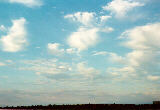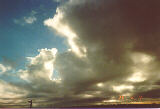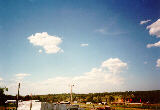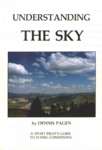 |
 |
 |
 |

Introduction.
Because of the complex nature of weather, I have decided not to go into too much detail but have tried to provide an interesting look at some of the important issues concerned with flying. Clicking on the topics listed in the contents below will allow you to navigate to the various sections.
As aspiring paragliding pilots, we need to understand how weather influences our sport before we take to the skies. It is important for a pilot to continuously monitor weather conditions. These conditions do change and pilots have often found themselves in great difficulty as a result. Conditions usually only allow a short "window" period for pilots to launch. The stronger your knowledge of being able to interpret flying conditions, the better your chances are of having a safer flying experience.
Weather is what happens over a short period of time. Climate is what happens over long periods of time. An example of weather would be rain in an area for a day or two, whereas an example of climate would be the conditions prevailing in a desert. As paragliding pilots we concern ourselves with weather and need to focus our understanding on this very interesting phenomena.
It should be emphasized that paragliding is an aerial sport and often has certain airspace restrictions placed on it. Without going into too much detail, you should be aware that we cannot just walk up any mountain and launch our paragliders. There are factors we need to be aware of like airspace restrictions and landowners permission (after all someone must own the piece of land we want to take-off or land on).
Time for some fun stuff. This is just an exercise to build your own pet cloud. Did you ever wish you could float on top of a cloud?
What you need to make your own cloud (children should not attempt this without their parents supervision). Follow the easy instructions:
| contents |
Flying regulations.
It should be emphasized that paragliding is an aerial sport and often has certain airspace restrictions placed on it. Without going into too much detail, you should be aware that we cannot just walk up any mountain and launch our paragliders. There are factors we need to be aware of like airspace restrictions and landowners permission (after all someone must own the piece of land we want to take-off or land on).
By joining a paragliding club or consulting with the correct authorities we can save ourselves both time and possible embarrassment before attempting to fly certain sites. One of the main reasons for following the correct procedures and protocol before flying is to prevent the sport of paragliding being negatively looked upon by the broader public.
Irresponsible behaviour by novice or ignorant pilots has often led to sites being jeopardized. With the growing interest in paragliding we cannot afford to lose the use of our flying sites. All pilots are expected to abide by the rules and ensure that non-compliance is severely dealt with.
| contents |
Have fun - create your own cloud.
Time for some fun stuff. This is just an exercise to build your own pet cloud. Did you ever wish you could float on top of a cloud?
What you need to make your own cloud (children should not attempt this without their parents supervision). Follow the easy instructions:
- A glass jug with a small mouth.
- A bunsen burner or candle.
- Light the bunsen burner/candle.
- Turn the jug upside down and hold its mouth over the flame for 10 seconds.
- Then immediately put your mouth inside the opening of the jug to make a seal (beware of burning those lips).
- Blow hard into the jug, and then remove your mouth.
- Watch as a cloud forms inside the jug.
How are clouds formed? (some interesting stuff)
Water can exist as a gas, liquid, or solid. Clouds are formed when air contains as much water vapour (gas) as it can hold. When the water in the cloud gets heavy enough, it falls out of the air as rain or snow. Fog and clouds are the same. If the moist air is lower that 50 feet, it is fog. If it is higher, it is a cloud. Clouds can form anywhere in the troposphere and can move from place to place with the wind. There are different types of clouds, based on their appearance and height above the ground:
Thermals are columns or bubbles of warm rising air. As paragliding pilots, we soon realize that a thermal is our friend. I should mention that there are basically two forms of lift that we will be concerned with:
Water can exist as a gas, liquid, or solid. Clouds are formed when air contains as much water vapour (gas) as it can hold. When the water in the cloud gets heavy enough, it falls out of the air as rain or snow. Fog and clouds are the same. If the moist air is lower that 50 feet, it is fog. If it is higher, it is a cloud. Clouds can form anywhere in the troposphere and can move from place to place with the wind. There are different types of clouds, based on their appearance and height above the ground:

|
Cirrus clouds look like hair or feathers blowing in the wind. They are very high in the sky where the air is cold. The moisture in these clouds is frozen into ice crystals instead of water droplets. Strong winds blow these clouds in long streamers across the sky. | |
| Stratus clouds look like sheets across the sky. They form when condensation happens at the same level at which the air stops rising. They often bring rain. | 
|
|

|
Cumulus clouds are puffy and can be many shapes and designs. These clouds have flat bottoms and billowy tops. | |
There are other clouds that are combinations of these three types. Check out the cool links below for more interesting stuff on weather and clouds.
| contents |
What are thermals?
Thermals are columns or bubbles of warm rising air. As paragliding pilots, we soon realize that a thermal is our friend. I should mention that there are basically two forms of lift that we will be concerned with:
- Thermals.
- Orographic or ridge lift.
To see how warm air rises try this simple, funfilled exercise. You will need the following:
An enclosed room, thermometer, step ladder, paper and pencil.
Dennis Pagen has written numerous highly acclaimed books relating to weather and other aspects of aviation. I have consulted various books, from his extensive range, in the compilation of the above information. You can click here to see the books written by this author. These books offer the discerning pilot some useful information and I highly recommend adding them to your personal library. As we all know "knowledge is strength".
1. Want to understand more about the weather.
2. Here is an excellent link, if you want to learn more about clouds and cloud types.
3. Find out your 5 day weather forecast.
An enclosed room, thermometer, step ladder, paper and pencil.
- In an enclosed room, place the thermometer on the floor. Wait at least a minute, then record the room temperature.
- Stand and hold the thermometer approximately 4 feet above the floor. Wait at least a minute, then record the room temperature, again.
- Climb at least 3 steps up the ladder with the thermometer. Wait at least a minute, then record the room temperature.
- Climb to the top of the ladder (if you think you may fall off, it may be a good idea to take your paraglider up the ladder with you - doh!!) with the thermometer. Wait at least a minute, then record the room temperature.
What did you discover? (The temperatures were different.)Where is the colder air? (Near the floor.) Where is the warmer air? (Near the ceiling. Amazing...)
During our flying adventures we will soon learn that we are dependent on these columns of rising air to remain aloft.
| contents |
Good reference material.
Dennis Pagen has written numerous highly acclaimed books relating to weather and other aspects of aviation. I have consulted various books, from his extensive range, in the compilation of the above information. You can click here to see the books written by this author. These books offer the discerning pilot some useful information and I highly recommend adding them to your personal library. As we all know "knowledge is strength".
| contents |
Some useful links.
1. Want to understand more about the weather.
2. Here is an excellent link, if you want to learn more about clouds and cloud types.
3. Find out your 5 day weather forecast.
| contents |


